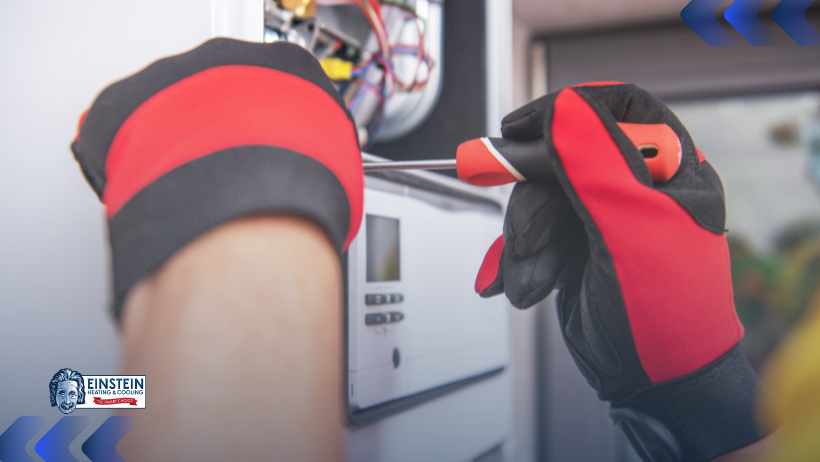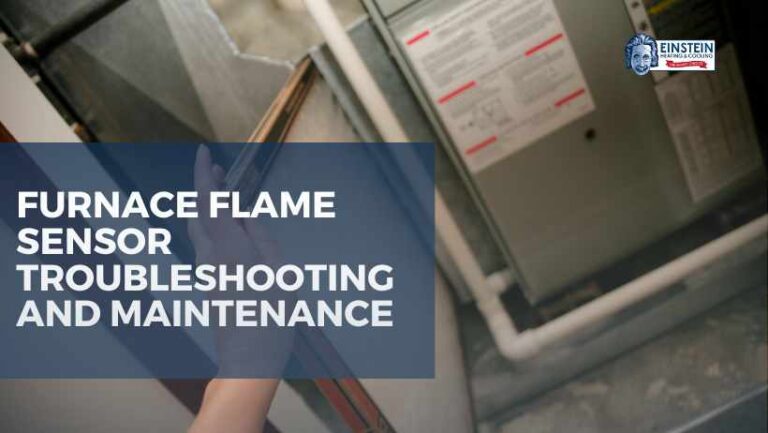The furnace flame sensor plays a crucial role in ensuring the efficiency and safety of the unit. Understanding its functions, troubleshooting potential issues, and performing regular maintenance can prolong the life of your furnace and save you from unexpected breakdowns. This comprehensive guide delves into the various aspects of the furnace flame sensor, shedding light on its significance and providing valuable insights for homeowners.
Anatomy of a Furnace Flame Sensor
Sensor Location
The furnace flame sensor is typically located near the burner assembly. Identifying its precise location is crucial for maintenance and troubleshooting purposes.
Sensor Composition
Furnace flame sensors are commonly made of durable materials such as stainless steel. Understanding the composition can help homeowners grasp the sensor’s resistance to extreme temperatures and environmental conditions as well as avoid complicated furnace repairs.
Sensor Functionality
The furnace flame sensor’s primary function is to detect a flame’s presence. It acts as a safety mechanism by ensuring that the burner ignites only when there is a consistent and stable flame.
Importance of a Well-Functioning Flame Sensor
Safety Measures
A properly functioning flame sensor furnace is essential for safety. It prevents the release of unburned gas into the home, reducing the risk of fire hazards and carbon monoxide leaks.
Energy Efficiency
An efficient flame sensor contributes to the overall energy efficiency of the furnace. A consistently burning flame ensures optimal combustion, translating into cost savings on energy bills.
Extended Furnace Lifespan
Regular maintenance and attention to the furnace flame sensor can extend the lifespan of the entire heating system. Timely detection and resolution of issues prevent further damage to the unit.
Signs of a Faulty Furnace Flame Sensor
Short Cycling
Short cycling refers to the furnace turning on and off frequently. A malfunctioning furnace ignition sensor may cause this behavior, disrupting the heating cycle and reducing efficiency.
Failure to Ignite
If the furnace fails to ignite, it may indicate a problem with the flame sensor. The sensor’s inability to detect the flame prevents the burner from staying lit.
Inconsistent Flame
An inconsistent flame, characterized by flickering or irregular patterns, can signal a malfunctioning flame sensor. This inconsistency may lead to unreliable heating and increased energy consumption.
When to Seek Professional Assistance
Persistent Issues
If DIY maintenance does not resolve the furnace ignition sensor issues, it’s advisable to seek professional assistance from expert HVAC technicians. Persistent problems may indicate underlying issues that require expert diagnosis.
Gas Smells
A strong smell of gas near the furnace is a serious concern and requires immediate attention. An HVAC technician should inspect the system to identify and address potential gas leaks.
Unusual Sounds
Strange noises emanating from the furnace, such as banging or clanking, may indicate more significant issues Asking the right questions when having your furnace repaired is essential. Professional intervention can help diagnose and address these problems.
Replacing a Furnace Flame Sensor
Turn Off Power
Before attempting to replace the furnace ignition sensor, turn off the power supply to the furnace. This precautionary step ensures safety during the replacement process.
Remove Old Sensor
Carefully detach the old flame sensor from its mounting bracket. Pay attention to the wiring and connections, ensuring a smooth removal process without damaging other components.
Install New Sensor
Install the new furnace flame sensor by securing it in the mounting bracket and reconnecting the wiring. Follow the manufacturer’s instructions for proper installation to ensure optimal performance.

Upgrading to Advanced Flame Sensor Technologies
UV Flame Sensors
Consider upgrading to UV flame sensors, which utilize ultraviolet light to detect the presence of a flame. These sensors are more immune to environmental factors, providing a higher level of accuracy in flame detection.
Infrared Flame Sensors
Infrared flame sensors are another advanced option, relying on the heat signature of the flame for detection. These sensors offer increased sensitivity and can be more reliable in challenging conditions.
Smart Sensor Integration
Explore smart sensor options that integrate with modern home automation systems. These sensors provide real-time monitoring and alerts, allowing homeowners to stay informed about their furnace’s status remotely.
Future-Proofing Your Furnace Flame Sensor
Regular System Inspections
Conduct regular inspections of your entire heating system, not just the furnace sensor. Addressing potential issues proactively can prevent major malfunctions and ensure the overall health of your furnace.
Firmware Updates
If your furnace sensor comes with programmable firmware, ensure that you keep it updated. Manufacturers may release firmware updates to enhance performance and address any known issues.
Professional Annual Servicing
Consider scheduling annual professional servicing for your heating system. A certified HVAC technician can perform a thorough inspection, clean components, and identify any potential problems before they escalate.
Safety Tips for Furnace Flame Sensor Maintenance
Wear Protective Gear
When performing any maintenance or replacement tasks, wear appropriate protective gear, including gloves and safety glasses, to ensure personal safety.
Adequate Ventilation
Ensure proper ventilation in the furnace area during maintenance tasks. Adequate ventilation prevents the accumulation of potentially harmful gases.
Turn Off Gas Supply
Before conducting any maintenance involving the furnace sensor or other components, turn off the gas supply to the furnace. This precautionary measure minimizes the risk of gas leaks.
Common Misconceptions about Furnace Flame Sensors
Cleaning with Abrasive Materials
Contrary to popular belief, using abrasive materials for cleaning the flame sensor can cause damage. Stick to soft brushes or cloths to avoid scratching or compromising the sensor’s surface.
DIY Repairs for Gas Leaks
Attempting to repair a gas leak without professional assistance is extremely hazardous. Always seek professional help if you detect the smell of gas around your furnace.
Ignoring Regular Maintenance
Some homeowners may need to pay more attention to the importance of regular maintenance for the furnace flame sensor. Ignoring this crucial task can lead to more significant problems in the long run.
DIY Maintenance Tips for Furnace Flame Sensors
Regular Cleaning
A fundamental yet impactful maintenance task involves cleaning the furnace sensor. Over time, dust and residue can accumulate on the sensor, hindering its ability to detect the flame accurately. Using a soft brush or cloth, delicately remove any debris to promote optimal sensor performance. This simple step can significantly enhance the sensor’s responsiveness and overall efficiency.
Checking Sensor Alignment
The correct alignment of the flame sensor is crucial for precise flame detection. Confirm that the sensor is positioned accurately and aligned with the burner. Misalignment can lead to inaccurate readings, affecting the furnace’s ability to function optimally. By ensuring proper alignment, you contribute to the seamless operation of your heating system, minimizing the risk of malfunctions.
Testing Sensor Continuity
Performing a continuity test using a multimeter is a valuable diagnostic step to assess the health of your furnace flame sensor. This test helps identify any breaks in continuity, indicating a potential issue with the sensor. If the continuity is compromised, it may be a sign that the sensor is faulty and requires replacement. Regularly conducting this test can help you catch problems early on, preventing more significant issues that could lead to system failures.
Inspecting Wiring Connections
Periodically examine the wiring connections associated with the furnace flame sensor. Over time, vibrations and heating cycles can lead to loosening or wear in the electrical connections. Ensure that all wires are securely attached and free from signs of corrosion. Addressing any issues with the wiring helps maintain a stable electrical connection, reducing the risk of sensor malfunctions and ensuring consistent performance.
Calibrating Sensor Sensitivity
Fine-tuning the sensitivity of the flame sensor can optimize its performance. Refer to your furnace’s user manual to understand the manufacturer’s recommendations for sensitivity settings. Using a small screwdriver, make slight adjustments as needed. This allows you to customize the sensor’s response to varying flame conditions, ensuring accurate detection without unnecessary shutdowns or false alarms.
Monitoring Flame Sensor Age
Like any component, furnace flame sensors have a limited lifespan. Keep track of the sensor’s age and consider replacing it if it exceeds the manufacturer’s recommended usage duration. Aging sensors may become less responsive or develop issues that affect their functionality. Regularly replacing the sensor as part of preventive maintenance can prevent unexpected breakdowns and enhance the overall longevity of your heating system.
Ensuring Proper Ventilation
Adequate ventilation is essential for the proper functioning of the furnace flame sensor. Check the surrounding area for any obstructions or debris that may impede airflow around the sensor. Restricted airflow can lead to inaccurate readings and compromise the sensor’s ability to detect the flame. Keeping the sensor area clear promotes efficient combustion and contributes to a safer and more reliable heating system.
Observing Flame Characteristics
Pay attention to the flame characteristics during regular operation. A consistent and blue flame indicates a healthy and efficient burn. If you notice any irregularities such as a flickering or yellow flame, it may signal an issue with the combustion process. Addressing such anomalies promptly can prevent damage to the flame sensor and other furnace components, ensuring optimal performance and energy efficiency. Regular observation allows you to catch potential problems early and take corrective measures.
Troubleshooting Common Issues
Addressing Sensor Contamination
How to clean the furnace flame sensor? Regular cleaning proves to be a crucial step in resolving this issue and restoring the sensor’s optimal functionality. Without adequate maintenance, these contaminants can obstruct the sensor’s ability to accurately detect the flame, leading to operational inefficiencies and potential malfunctions. By implementing a routine cleaning schedule, technicians can ensure the sensor remains free from obstructions, allowing it to function effectively and contribute to the overall efficiency of the heating system.
Resolving Wiring Problems
Faulty wiring or loose connections significantly threaten the seamless communication between the flame sensor and the furnace control board. This communication breakdown can disrupt the sensor’s ability to convey accurate information, potentially causing operational disruptions. To tackle wiring issues, thorough inspection becomes imperative. Technicians should meticulously examine the entire wiring system, identifying and rectifying any loose connections or damaged wires. By ensuring a secure and stable connection, technicians can eliminate a potential source of malfunction, allowing the flame sensor to effectively communicate with the control board and maintain the furnace’s optimal performance.
Calibration Adjustment
In some cases, the flame sensor furnace may experience issues related to calibration. Over time, factors such as temperature variations or wear and tear can lead to misalignment in the sensor’s calibration. Calibration adjustment becomes crucial in ensuring the sensor accurately interprets the flame’s presence and intensity. Technicians should carefully recalibrate the sensor, aligning it with the manufacturer’s specifications. This meticulous adjustment helps maintain the sensor’s precision, preventing false readings and optimizing its performance.
Gas Supply Irregularities
Flame sensor functionality can be adversely affected by irregularities in the gas supply. Low gas pressure or intermittent supply can lead to improper combustion, affecting the sensor’s ability to detect and monitor the flame. HVAC technicians should assess the gas supply system, checking for any leaks, pressure fluctuations, or blockages that may compromise the sensor’s performance. Addressing these gas supply issues ensures a consistent and reliable fuel source for the furnace, allowing the flame sensor to operate at its best.
Conclusion
A well-informed approach to furnace flame sensor care goes beyond basic maintenance. By dispelling common misconceptions and staying proactive in your approach to professional maintenance from Einstein Heating and Cooling, you can enjoy a consistently warm and safe home environment throughout the colder seasons. Remember, a small investment in care today can prevent major repairs tomorrow.








